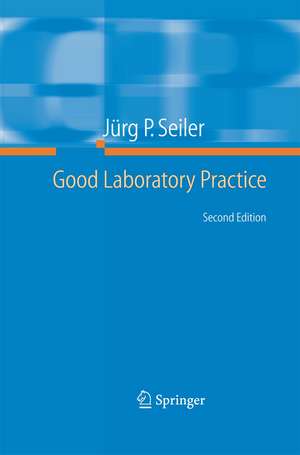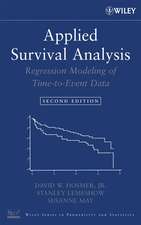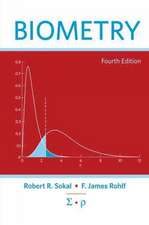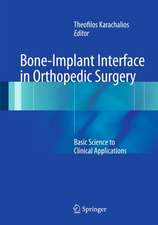Good Laboratory Practice: the Why and the How
Autor Jürg P. Seileren Limba Engleză Paperback – 27 noi 2014
| Toate formatele și edițiile | Preț | Express |
|---|---|---|
| Paperback (1) | 1165.19 lei 6-8 săpt. | |
| Springer Berlin, Heidelberg – 27 noi 2014 | 1165.19 lei 6-8 săpt. | |
| Hardback (1) | 1424.52 lei 6-8 săpt. | |
| Springer Berlin, Heidelberg – 30 iun 2005 | 1424.52 lei 6-8 săpt. |
Preț: 1165.19 lei
Preț vechi: 1226.52 lei
-5% Nou
Puncte Express: 1748
Preț estimativ în valută:
222.98€ • 242.13$ • 187.31£
222.98€ • 242.13$ • 187.31£
Carte tipărită la comandă
Livrare economică 23 aprilie-07 mai
Preluare comenzi: 021 569.72.76
Specificații
ISBN-13: 9783642441035
ISBN-10: 3642441033
Pagini: 440
Ilustrații: XII, 424 p.
Dimensiuni: 155 x 235 x 23 mm
Greutate: 0.61 kg
Ediția:2nd ed. 2005
Editura: Springer Berlin, Heidelberg
Colecția Springer
Locul publicării:Berlin, Heidelberg, Germany
ISBN-10: 3642441033
Pagini: 440
Ilustrații: XII, 424 p.
Dimensiuni: 155 x 235 x 23 mm
Greutate: 0.61 kg
Ediția:2nd ed. 2005
Editura: Springer Berlin, Heidelberg
Colecția Springer
Locul publicării:Berlin, Heidelberg, Germany
Public țintă
ResearchDescriere
After more than twenty years of use Good Laboratory Practice, or GLP, has attained a secure place in the world of testing chemicals and other “test items” with regard to their safety for humans and the environment. Gone are the days when the GLP regulations were hotly debated amongst scientists in academia and industry and were accused of stifling flexibility in, imaginative approaches to, and science-based conduct of, all kinds of studies concerned with toxic effects and other parameters important for the evaluation and assessment of products submitted for registration and permission to market. The GLP regulations have developed from rules on how to exactly document the planning, conduct and reporting of toxicity studies to a quality system for the management of a multitude of study types, from the simple determination of a physical/chemical parameter to the most complex field studies or ecotoxicology studies. At the same time the term “Good Laboratory Practice” has become somewhat of a slogan with the aim to characterise any reliably conducted laboratory work.
Cuprins
I. What is Good Laboratory Practice All About?- 1. Introduction.- 2. The History of GLP.- 2.1 The Early Days and the Causative Events.- 2.2 The First Regulations.- 2.3 International Ripples: The OECD Principles.- 2.4 The Principles and Their Interpretation.- 2.5 Closing the Circle? – The Detection of Test Item in Control Samples.- 3. The Idea Behind GLP.- 4. The Areas of Application.- 5. The Pillars of Good Laboratory Practice.- 6. Where Can GLP be Profitably Applied?- 7. GLP and Other Laboratory Quality Systems.- II. How is Good Laboratory Practice Regulated?- 1. Introduction.- 2. Definitions in GLP.- 2.1 Good Laboratory Practice.- 2.2 Management.- 2.3 Study Director and Principal Investigator.- 2.4 Test Facility and Test Site.- 2.5 The Study.- 2.6 Short-Term Studies.- 2.7 Initiation, Starting and Completion Dates.- 2.8 Study Plan, Amendments and Deviations.- 2.9 Raw Data 94.- 2.10 The Phases of a Study.- 2.11 The Master Schedule.- 2.12 Test and Reference Item.- 2.13 Additional Definitions.- 3. Responsibilities in Good Laboratory Practice.- 3.1 Management.- 3.2 Study Director and Principal Investigator.- 3.3 Study Personnel.- 3.4 The Sponsor.- 4. The Quality Assurance Programme.- 4.1 General Considerations.- 4.2 Quality Assurance Inspections.- 4.3 Quality Assurance Inspection Reports.- 4.4 Audits of Raw Data and of Final Reports.- 4.5 The Quality Assurance Statement.- 5. Facilities.- 5.1 General Requirements.- 5.2 Test System Facilities.- 5.3 Facilities for Handling Test and Reference Items.- 5.4 Archive Facilities.- 6. Apparatus, Materials and Reagents.- 7. Computerised Systems.- 7.1 Introduction.- 7.2 Basic Considerations.- 7.3 Data considerations.- 7.4 Prospective Validation.- 7.5 Retrospective Evaluation.- 7.6 Maintenance and Change Control.- 7.7 Security.- 7.8 Levels of Complexity.- 8. Test Systems.- 8.1 Physical/Chemical Test Systems.- 8.2 Biological Test Systems.- 9. Test and Reference Items.- 9.1 Handling andDocumentation.- 9.2 Characterisation.- 9.3 Expiry Dates.- 9.4 Sample Retention.- 10. Standard Operating Procedures.- 10.1 Introduction.- 10.2 The Format.- 10.3 Issue, Approval and Distribution.- 10.4 On-line SOPs.- 10.5 The Content.- 10.6 Where are SOPs required?- 11. Study Performance and Reporting.- 11.1 The Study Plan.- 11.2 Study Conduct.- 11.3 The Final Report.- 11.4 Re-opening and Amending a Study.- 11.5 Discontinued Studies.- 12. The Archives.- 12.1 Storage Period.- 12.2 Indexing and Retrieval.- 12.3 Security.- 12.4 Archiving of Electronic Raw Data.- 12.5 Archive location, merging and dissolution.- III. How can Good Laboratory Practice be Introduced in a Test Facility?- 1. Introduction.- 2. General Aspects.- 3. A General Way to Implementation.- 3.1 The preliminaries.- 3.2 The organisation.- 3.3 Separation and distribution of facilities and equipment.- 3.4 Interlude: Personnel documentation.- 3.5 Distributing Responsibilities.- 3.6 The Major Task: Standard Operating Procedures.- 3.7 Second Interlude: Quality Assurance and IT.- 3.8 The Personnel: Education and Training.- 3.9 Study Plans.- 3.10 Test and Reference Item Issues.- 3.11 Study Conduct.- IV. How is Compliance with Good Laboratory Practice Monitored?- 1. Introduction.- 2. National Monitoring Authorities.- 3. MOUs, MRAs, and MJVs.
Recenzii
From the reviews of the second edition:
"This second edition has clarified and expanded numerous aspects of the GLP requirements from the previous edition … . The book is very detailed in its discussion of each section of the GLP principles and explains the meaning of each of these requirements. … In summary, the book is of value to those individuals new to the discipline of GLP, those who require clarification on GLP requirements and those organisations implementing GLP for the first time." (T. R. Stiles, BTS Newsletter, Issue 28, 2006)
"The book delivers a comprehensive examination of the critically important regimen of GLP. For laboratory managers it is a ‘must’ for initiating or enhancing laboratory contribution to clinical and environmental studies." (Geoffrey Phillips, The Pharmaceutical Journal, 2007)
"This second edition has clarified and expanded numerous aspects of the GLP requirements from the previous edition … . The book is very detailed in its discussion of each section of the GLP principles and explains the meaning of each of these requirements. … In summary, the book is of value to those individuals new to the discipline of GLP, those who require clarification on GLP requirements and those organisations implementing GLP for the first time." (T. R. Stiles, BTS Newsletter, Issue 28, 2006)
"The book delivers a comprehensive examination of the critically important regimen of GLP. For laboratory managers it is a ‘must’ for initiating or enhancing laboratory contribution to clinical and environmental studies." (Geoffrey Phillips, The Pharmaceutical Journal, 2007)
Caracteristici
Quality assurance has become a hot topic in research laboratories
A practice-oriented handbook on how to implement GLP in a laboratory
Covers basic principles, operating procedures, international OECD standards
Vital information on how to survive GLP monitoring
A practice-oriented handbook on how to implement GLP in a laboratory
Covers basic principles, operating procedures, international OECD standards
Vital information on how to survive GLP monitoring















